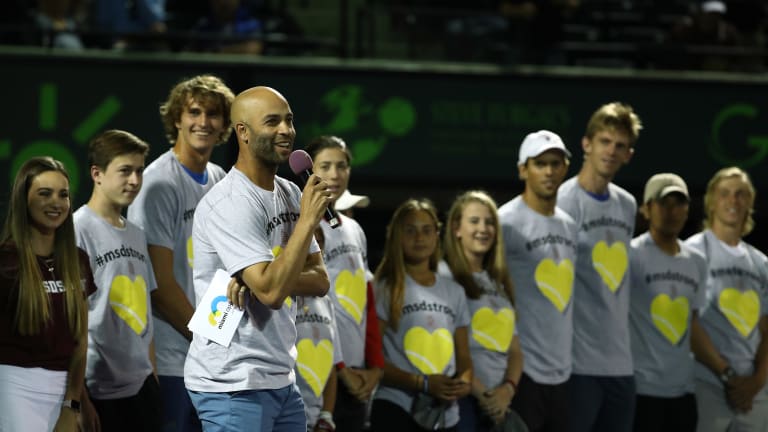James Blake is taking his talents to South Beach
By Steve Tignor Mar 20, 2019In beating idol Novak Djokovic, Jakub Mensik came of age in Miami
By Steve Tignor Mar 31, 2025Can Jessica Pegula step out of comfort zone on clay?
By Pete Bodo Mar 31, 2025Jakub Mensik, Miami champion, was going to pull out of the tournament an hour before his first match
Mar 31, 2025Teenager Jakub Mensik denies Novak Djokovic 100th title in Miami Open upset
By TENNIS.com Mar 31, 2025Aryna Sabalenka takes aim at Iga Swiatek's dominance of the European clay season
By Steve Tignor Mar 31, 2025Novak Djokovic vs. Jakub Mensik: Where to watch, and who will win, their Miami Open final
By TENNIS.com Mar 30, 2025Roger Goodell watches on as Aryna Sabalenka defeats Jessica Pegula in Miami final
By Associated Press Mar 29, 2025Aryna Sabalenka masters Jessica Pegula again to win Miami Open
By TENNIS.com Mar 29, 202519-year-old Jakub Mensik to face Novak Djokovic in Miami Open final
By David Kane Mar 29, 2025James Blake is taking his talents to South Beach
The Miami Open will have a brand new look this spring, while its tournament director, James Blake, will be making a transition of his own.
Published Mar 20, 2019
Advertising
When James Blake retired from tennis in 2013, he did what thousands of other ex-Ivy Leaguers before him have done: he thought about going into banking. Blake was 33 instead of 23, and his two years at Harvard were long behind him. Unlike most Wall Street wannabes, though, he had already earned nearly $8 million in prize money, criss-crossed the globe dozens of times, helped the U.S. bring home the Davis Cup and recorded wins over Roger Federer and Rafael Nadal.
But all of the years spent pounding tennis balls, and pounding his legs across asphalt courts, had left Blake wondering if he should try another, less-taxing line of work. It wouldn’t be so bad to get out of the sun and sit behind a desk, would it?
“I took some time away—it ended up being about nine months—to get an idea of what my options were. I looked into finance and banks, and saw what it might be like to work in an office,” Blake says, sounding slightly incredulous at the memory. “When you’ve been traveling non-stop for a decade, you think you might want to stay in one place for a while.”
If there’s one thing that will make a pro athlete appreciate what he does for a living, it’s the prospect of having to do just about anything else. When he was young, a burned-out David Ferrer quit tennis to become a brick layer; it would be 20 years before he dared to put his racquet down again. After his first retirement, at age 25, Bjorn Borg tried every occupation from rally-car driver to TV commentator to underwear salesman to professional libertine before making an inglorious return to the tour. For Blake, nine months away were more than enough.
“It’s pretty simple: I realized that I loved tennis, and I wanted to be part of it in any way I could,” says Blake, who has spent the past few years as an analyst for Tennis Channel. “I wanted to use whatever wisdom I’ve gained to help the sport.”

James Blake is taking his talents to South Beach
© 2018 Getty Images
Advertising
In 2012, Blake married publicist Emily Snider; the couple has two children, Riley and Emma. Rather than take an office job in Manhattan, Blake moved to sports-rich San Diego.
“It’s 70 degrees and sunny everyday, which isn’t a bad thing,” he says.
But in 2015, Blake’s life took a jarringly unexpected turn, one that seemed as if it might push him in a new direction entirely. While he was on his cell phone outside a Manhattan hotel during the US Open, Blake was tackled by an undercover NYPD officer in a case of mistaken identity. The incident, which was captured on a surveillance video that quickly went viral, inspired this well-mannered family man from the Connecticut suburbs to become what he described as an “accidental activist” at age 35.
“I immediately called my wife. And that’s when I realized how big a deal this was,” Blake told NPR of his reaction to the attack. “I’m an athlete. I’ve been taught to be the tough guy. And I just wanted to sweep this under the rug. I just told her I was angry, but I’m going to, you know, just go about my day. And she just said, ‘What if this happened to me?’”
“And it immediately hit me. I started actually tearing up a little bit and thinking about what I would have done if this happened to someone I loved. After that, it definitely changed my perspective and made me a little bit more defiant.”
Blake’s measured defiance led him to sue the city of New York. Rather than demand monetary damages, he succeeded in having the NYPD start a fellowship that would fund investigations into police misconduct.
Two years later, Blake’s changed perspective would lead him to publish his second book, Ways of Grace: Stories of Activism, Adversity, and How Sports Can Bring Us Together. Taking his title from Arthur Ashe’s final autobiography, Days of Grace, Blake recounted the principled stands that athletes of the past have taken for their political beliefs.
Some began to wonder whether a career in politics might be in Blake’s future. His thoughtful, even-keel persona seemed like a natural extension of Ashe’s, and even Barack Obama’s. But Blake has seen enough of the politician’s life, and the indignities it entails, to realize it’s not for him.
“I know some people have said I would be a good fit for it,” Blake says of the political world. “But I’ve been disillusioned. The rewards aren’t worth everything you have to do, everything that happens to you and your family.”
For Blake, activism is less a responsibility than it is an opportunity.
“I don’t believe [athletes] bear a responsibility that they have to do this in any way,” he told NPR. “But if something really does bring you to tears or gives you this kind of emotion, or it’s something that you feel is an injustice, and you need to speak out, then, yeah, you have a platform.”

James Blake is taking his talents to South Beach
© 2018 Getty Images
Advertising
With Mark Shapiro, Serena Williams and Stephen Ross, Blake is helping the Miami Open put down roots in the concrete heart of the city (left). As a Tennis Channel commentator, he remains connected to the tour and its players.
Last year, Blake’s mix of political savvy and playing experience helped him step onto a new platform, when he was hired by the Miami Open to be its tournament director. In the position, Blake serves as a liaison between players and officials, and gives the event a familiar and popular public face. But his first year on the job wasn’t all smooth sailing. After losing to local favorite Monica Puig, top seed Caroline Wozniacki claimed that her family had received death threats from fans during the match. Blake’s response, that courtside staff and security hadn’t been notified of any threats, wasn’t strong enough for Wozniacki, who talked about boycotting the tournament next year.
In 2019, Blake has faced a new challenge: tearing up the Miami Open’s 33-year-old roots on the idyllic island of Key Biscayne, and putting them down again in the parking lot of a football arena downtown. After years of trying, and failing, to get approval to renovate and expand in Crandon Park, the tournament finally found room across the bay at Hard Rock Stadium, home of the Miami Dolphins.
In Dolphins owner and real estate mogul Stephen Ross, it also found a patron who could conceivably match the deep-pocketed commitment that Larry Ellison has brought to the Miami Open’s chief rival, the BNP Paribas Open in Indian Wells. Ross will oversee construction of a 13,800-seat temporary stadium court inside the arena, and a permanent facility outside Hard Rock Stadium that will house 12 match courts and 18 practice courts.
While the transition may not be a natural one for players and longtime fans, Blake likes what he sees so far.
“I’m excited about the move,” Blake says. “I think some players may have wondered what [the facility] would be like, but they’ve seen the renderings, and I think they understand how beautiful it can be.”
If advance ticket sales are an indication, the same seems to be true of fans. By January, sales were up 22 percent over the same time in 2018.
“You don’t normally associate tennis with football, but sports fans are sports fans, and I think we’ve done a good job tapping into the Dolphins base,” Blake says about the reaction. “It will also be easier for people north of the city, in Broward County and Palm Beach, to come down.”
The tournament’s move will be another learning experience for Blake.
“I’ve got a new appreciation for what goes into running a tournament,” he says. “Just putting together the schedule each day. As a player, you’re like, ‘What’s the problem? Just put it out!’ But there are so many intricacies to it, so many chefs in the kitchen.”
Blake says there are “added elements” he can bring to the event, through his knowledge of the players’ perspective, and his relationships with the game’s older stars. He’s pleased that Serena and Venus Williams, Novak Djokovic, Nadal and Federer can still be potential drawing cards in Miami.
“I think it’s great, because we’re witnessing history,” Blake says of the continued dominance of these veterans. “I’m also partial, because I played against them and with them, and I think they’re incredible human beings. Whether it’s Alexander Zverev or Felix Auger-Aliassime who makes a big move, I’m not worried about the next generation. The transition will come.”

James Blake is taking his talents to South Beach
© 2018 Getty Images
Advertising
In his first year as the Miami Open’s tournament director, Blake invited the boys’ and girls’ tennis teams from Marjory Stoneman Douglas High School, in Parkland, FL, to show support and benefit survivors of the shooting that had occurred just a month earlier.
As for Blake’s own role in the sport’s future, he’s not ready to jump into coaching yet—“To do it right, you’ve got to be there 30 weeks, and I have a 6-year-old and a 4-year-old at home,” he says. But he believes an increased emphasis on coaching is the key to any improvement in U.S. tennis fortunes.
“It’s such a broad country, we can’t have a top-down approach. We need to encourage coaches to work their own way,” Blake says. “We need to support them financially, but not everyone has to play the game the same way.”
As Blake approaches 40, he knows he’s committed to tennis, in one form or another, for the long haul. Whether it’s on the court as a coach, or off the court as an official or an activist voice, Blake’s platform will come.